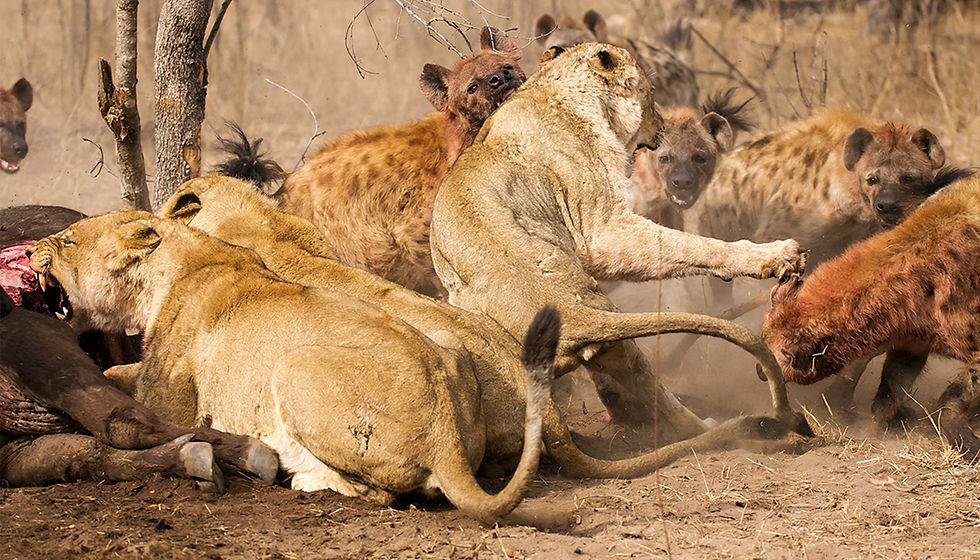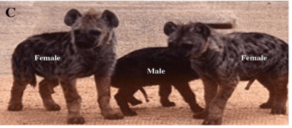Hyenas: That unknown animal.
- Beli Day

- 19 jun 2020
- 4 Min. de lectura
Sawubona adventurers! As you asked, in this new blog entry I bring you the hyenas, more correctly speaking, the spotted hyena (Crocuta crocuta). This animal is very defamed, it is said that it smells bad, that it is evil, that it steals food from other animals... and a lot of things that make it an animal quite hated by people (and although I love the movie, the lion king did a lot of damage in this case ). So here I come to try to get you a little closer to them so that you can get to know them better and see what a fabulous animal they are, let's go!

To start with, I'm going to tell you about their social organization, that's how they relate to each other. They are organized in matriarchies, this means that the females are the dominant ones in the clans (this is the name given to a group of hyenas), there being always an Alpha female. The number of hyenas that can exist in a clan is directly linked to the amount of prey that there is in the territory, and solitary individuals can be seen in areas where ungulates (mammals with hooves) are scarce or clans of up to 80 individuals where food is abundant. The hierarchy within the clan is very marked, the Alpha female and her progeny (males and females) will always be dominant over the rest of the clan, the other females being next in the hierarchy and leaving the males as the base of the pyramid. These males will have no other use for the clan than hunting in groups or as a defence, they will never mate with females from the same clan and it will only be passing males who try to mate with them (these are usually males that are the offspring of Alphas females from other clans, who are much more trusting and daring), this behaviour helps to maintain the purity of the blood.

Many of us will have heard that hyenas are hermaphrodites, but this is not true. It is true that females have a reproductive system very similar to that of the male, sometimes making it very difficult to sex them at first sight. But this male aspect in females is due to the high level of testosterone (male hormone) that they carry, with the Alpha female having much more testosterone than any other male, and the lower category females approximately the same as the males. This development is believed to be something that hyenas needed in order to be able to raise their offspring in the face of so much competition and so the hyena society became matriarchal.
Hyenas give birth in dens that they excavate by themselves or they occupy warthogs or aardvarks burrows that have been abandoned. They usually give birth to twins with their eyes open, but blind, and already with teeth; in some cases fratricide (killing each other between siblings) can occur if the mother does not provide enough milk. At the age of 10 days the mother will move them to a common den where they will live with cubs of different ages and with whom they will learn to socialise and mark out new hierarchies, it will be the mothers who will look for their own cubs to suckle them, and although at the age of 2 and a half months they can eat meat, they will take milk from the mother until they are a year and a half old, as hyenas are not very given to bringing food into the den, only on rare occasions.
Hyenas are often pigeonholed as scavengers, but it must be said that any animal is a scavenger if the opportunity arises, the law of least effort is quite prevalent in the wild... it will always be easier to steal than to take the risk of hunting. But whether hyenas are more scavengers or more hunters is related to the lion population in the area, both species share prey and there is usually a lot of competition between them. In areas where the lions outnumber the hyenas, the latter usually take advantage of the lions' offal and even dare to steal prey, although this is very rarely the case if there are male lions; but if the hyenas are more numerous than the lions, the case is reversed and it is the lions that become more scavengers and the hyenas more hunters.

I should add that hyenas are an important link in the food chain as they consume all their prey, even the bones; at mealtimes there is no aggressive competition but rather it is governed by who eats the fastest, with cases where 20 hyenas devoured a 100kg wildebeest in 13 minutes. For this reason hyena droppings are rich in calcium helping both plants and some animals that consume these deposits to absorb much-needed calcium.
I hope that knowing a little bit more about this animal will make them see how complex and fabulous they can be, sometimes we must leave aside the popular fame given to certain animals and investigate a little bit to discover that they are more than well adapted to their environment and discover how exceptional many species are with a bad reputation.
Impilo enh adventurers!
















Comentarios